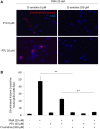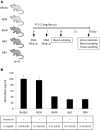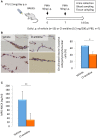Peptidylarginine Deiminase Inhibitor Suppresses Neutrophil Extracellular Trap Formation and MPO-ANCA Production
- PMID: 27375623
- PMCID: PMC4896908
- DOI: 10.3389/fimmu.2016.00227
Peptidylarginine Deiminase Inhibitor Suppresses Neutrophil Extracellular Trap Formation and MPO-ANCA Production
Abstract
Myeloperoxidase-antineutrophil cytoplasmic antibody (MPO-ANCA)-associated vasculitis is a systemic small-vessel vasculitis, wherein, MPO-ANCA plays a critical role in the pathogenesis. Neutrophil extracellular traps (NETs) released from activated neutrophils are composed of extracellular web-like DNA and antimicrobial proteins, including MPO. Diverse stimuli, such as phorbol myristate acetate (PMA) and ligands of toll-like receptors (TLR), induce NETs. Although TLR-mediated NET formation can occur with preservation of living neutrophilic functions (called vital NETosis), PMA-stimulated neutrophils undergo cell death with NET formation (called suicidal NETosis). In the process of suicidal NETosis, histones are citrullinated by peptidylarginine deiminase 4 (PAD4). Since this step is necessary for decondensation of DNA, PAD4 plays a pivotal role in suicidal NETosis. Although NETs are essential for elimination of microorganisms, excessive formation of NETs has been suggested to be implicated in MPO-ANCA production. This study aimed to determine if pan-PAD inhibitors could suppress MPO-ANCA production in vivo. At first, NETs were induced in peripheral blood neutrophils derived from healthy donors (1 × 10(6)/ml) by stimulation with 20 nM PMA with or without 20 μM propylthiouracil (PTU), an anti-thyroid drug. We then determined that the in vitro NET formation was inhibited completely by 200 μM Cl-amidine, a pan-PAD inhibitor. Next, we established mouse models with MPO-ANCA production. BALB/c mice were given intraperitoneal (i.p.) injection of PMA (50 ng at days 0 and 7) and oral PTU (2.5 mg/day) for 2 weeks. These mice were divided into two groups; the first group was given daily i.p. injection of PBS (200 μl/day) (n = 13) and the other group with daily i.p. injection of Cl-amidine (0.3 mg/200 μl PBS/day) (n = 7). Two weeks later, citrullination as an indicator of NET formation in the peritoneum and serum MPO-ANCA titer was compared between the two groups. Results demonstrated that citrullination in the peritoneum was significantly reduced in the Cl-amidine-treated mice compared with the vehicle-injected control mice (38% reduction). Additionally, the serum MPO-ANCA titer of the Cl-amidine-treated mice (32.3 ± 31.0 ng/ml) was significantly lower than that in the vehicle-injected mice (132.1 ± 41.6 ng/ml). The collective findings indicate that excessive formation of NETs may be implicated in MPO-ANCA production in vivo.
Keywords: MPO-ANCA; MPO-ANCA-associated vasculitis; neutrophil extracellular trap; peptidylarginine deiminase 4; peptidylarginine deiminase inhibitor.
Figures



Similar articles
-
Abnormal conformation and impaired degradation of propylthiouracil-induced neutrophil extracellular traps: implications of disordered neutrophil extracellular traps in a rat model of myeloperoxidase antineutrophil cytoplasmic antibody-associated vasculitis.Arthritis Rheum. 2012 Nov;64(11):3779-87. doi: 10.1002/art.34619. Arthritis Rheum. 2012. PMID: 22777766
-
Lipopolysaccharide-induced neutrophil extracellular trap formation in canine neutrophils is dependent on histone H3 citrullination by peptidylarginine deiminase.Vet Immunol Immunopathol. 2017 Dec;193-194:29-37. doi: 10.1016/j.vetimm.2017.10.002. Epub 2017 Oct 20. Vet Immunol Immunopathol. 2017. PMID: 29129225
-
Myeloperoxidase anti-neutrophil cytoplasmic antibody affinity is associated with the formation of neutrophil extracellular traps in the kidney and vasculitis activity in myeloperoxidase anti-neutrophil cytoplasmic antibody-associated microscopic polyangiitis.Nephrology (Carlton). 2016 Jul;21(7):624-9. doi: 10.1111/nep.12736. Nephrology (Carlton). 2016. PMID: 26833773 Free PMC article.
-
Neutrophil Extracellular Traps in ANCA-Associated Vasculitis.Front Immunol. 2016 Jun 30;7:256. doi: 10.3389/fimmu.2016.00256. eCollection 2016. Front Immunol. 2016. PMID: 27446086 Free PMC article. Review.
-
NETosis markers: Quest for specific, objective, and quantitative markers.Clin Chim Acta. 2016 Aug 1;459:89-93. doi: 10.1016/j.cca.2016.05.029. Epub 2016 May 31. Clin Chim Acta. 2016. PMID: 27259468 Review.
Cited by
-
ANCA-Associated Vasculitis: An Update.J Clin Med. 2021 Apr 1;10(7):1446. doi: 10.3390/jcm10071446. J Clin Med. 2021. PMID: 33916214 Free PMC article. Review.
-
Remission of Granulomatosis with Polyangiitis Only After Resection of a Pulmonary Nodule.Intern Med. 2022;61(18):2803-2808. doi: 10.2169/internalmedicine.8447-21. Epub 2022 Sep 15. Intern Med. 2022. PMID: 36104178 Free PMC article.
-
Regulation of Pseudomonas aeruginosa-Mediated Neutrophil Extracellular Traps.Front Immunol. 2019 Jul 18;10:1670. doi: 10.3389/fimmu.2019.01670. eCollection 2019. Front Immunol. 2019. PMID: 31379861 Free PMC article.
-
Diagnostic and Therapeutic Approach in ANCA-Associated Glomerulonephritis: A Review on Management Strategies.Front Med (Lausanne). 2022 Jun 3;9:884188. doi: 10.3389/fmed.2022.884188. eCollection 2022. Front Med (Lausanne). 2022. PMID: 35721093 Free PMC article. Review.
-
Increased Circulating PD-1 hi CXCR5 - Peripheral T Helper Cells are Associated with Disease Activity of ANCA-Associated Vasculitis.Clin Exp Immunol. 2022 Jan 12;207(3):287-96. doi: 10.1093/cei/uxac002. Online ahead of print. Clin Exp Immunol. 2022. PMID: 35022684 Free PMC article.
References
-
- Kallenberg CG. Pathogenesis and treatment of ANCA-associated vasculitides. Clin Exp Rheumatol (2015) 33:S11–4. - PubMed
-
- Nakazawa D, Tomaru U, Suzuki A, Masuda S, Hasegawa R, Kobayashi T, et al. Abnormal conformation and impaired degradation of propylthiouracil-induced neutrophil extracellular traps: implications of disordered neutrophil extracellular traps in a rat model of myeloperoxidase antineutrophil cytoplasmic antibody-associated vasculitis. Arthritis Rheum (2012) 64:3779–87.10.1002/art.34619 - DOI - PubMed
LinkOut - more resources
Full Text Sources
Other Literature Sources
Research Materials
Miscellaneous

